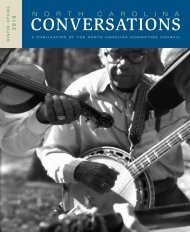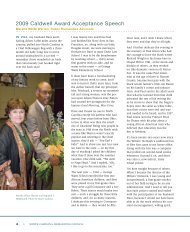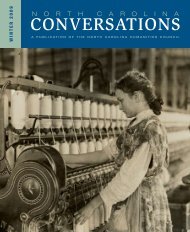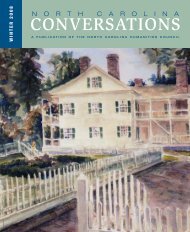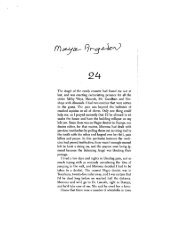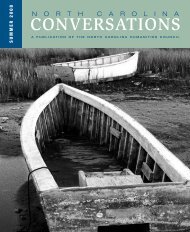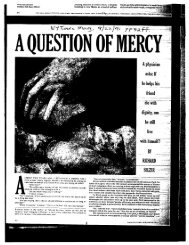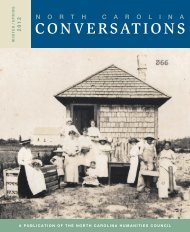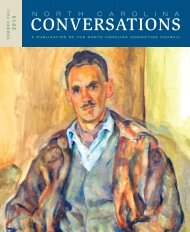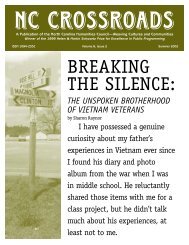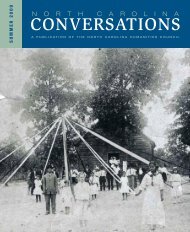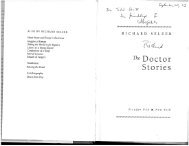A Publication of the North Carolina Humanities Council—Weaving ...
A Publication of the North Carolina Humanities Council—Weaving ...
A Publication of the North Carolina Humanities Council—Weaving ...
Create successful ePaper yourself
Turn your PDF publications into a flip-book with our unique Google optimized e-Paper software.
“a sense <strong>of</strong> community”<br />
Over in <strong>the</strong> 100 alley <strong>of</strong> <strong>the</strong> weave room, I could see two members <strong>of</strong> <strong>the</strong> Glade Hill Rescue<br />
Squad trying to discuss something in <strong>the</strong> loom roar. In <strong>the</strong> 400 alley, a soprano and a<br />
baritone from <strong>the</strong> Redwood Methodist Church Choir tended to troublesome sample<br />
runs. rom where I sat on my wobbly scaffolding over <strong>the</strong> looms, I could see husband<br />
and wife, fa<strong>the</strong>r and son, right fielders and <strong>the</strong>ir short stops, deer hunters, Ruritans and women <strong>of</strong><br />
<strong>the</strong> Be<strong>the</strong>l Baptist Ladies Auxiliary—in short I could see dozens <strong>of</strong> kinds <strong>of</strong> allegiances, bonds <strong>of</strong><br />
both blood and belief. And, I was about to see those bonds tested.<br />
It was <strong>the</strong> summer <strong>of</strong> 1978, and I was spending my college break working in <strong>the</strong> maintenance<br />
department <strong>of</strong> <strong>the</strong> textile mill in my hometown. I’d been assigned to clean <strong>the</strong> tin shades and<br />
replace flickering fluorescent tubes in <strong>the</strong> lights above <strong>the</strong> thrashing Draper looms <strong>of</strong> <strong>the</strong> mill’s<br />
weave rooms. It was a typical sou<strong>the</strong>rn summer, drenched with humidity which was exaggerated<br />
by <strong>the</strong> water jets in <strong>the</strong> ceiling <strong>of</strong> <strong>the</strong> weave room that kept <strong>the</strong> yarn from raveling. There was talk <strong>of</strong><br />
s<strong>of</strong>tball games, NASCAR wins, quarts <strong>of</strong> beans canned and one o<strong>the</strong>r thing—<strong>the</strong> thing that would<br />
strain <strong>the</strong> bonds that years <strong>of</strong> familiarity had fashioned—<strong>the</strong> union.<br />
This particular summer <strong>the</strong> Amalgamated Clothing and Textile Workers’ Union (ACTWU) had<br />
targeted this mill for organization. rom my catbird seat above <strong>the</strong> looms, I watched union<br />
advocates work <strong>the</strong> weave room, convincing some, alienating o<strong>the</strong>rs, and I watched <strong>the</strong><br />
management, who shared with <strong>the</strong> weave rooms’ workers many <strong>of</strong> <strong>the</strong> allegiances <strong>of</strong> church and<br />
community, work against <strong>the</strong> union. As <strong>the</strong> “college boy,” I was one <strong>of</strong> <strong>the</strong>m and not one <strong>of</strong> <strong>the</strong>m,<br />
with <strong>the</strong>m and, literally, removed from <strong>the</strong>m. At <strong>the</strong> time I understood little <strong>of</strong> what I was witnessing,<br />
but <strong>the</strong> images <strong>of</strong> <strong>the</strong>ir daily lives stayed with me.<br />
Nearly 20 years later I was visiting with my fa<strong>the</strong>r, who had retired from his position as <strong>the</strong> mill’s<br />
personnel manager. I asked him to take me back into <strong>the</strong> mill. As we walked through <strong>the</strong> weave<br />
rooms and he shook hands and squeezed shoulders, leaned close to people’s ears to shout through<br />
<strong>the</strong> loom roar, <strong>the</strong> images rushed back to me and I began to see <strong>the</strong>m in <strong>the</strong> context <strong>of</strong> this vital<br />
community whose bonds had held up under <strong>the</strong> strain <strong>of</strong> social and economic conflict. The poems<br />
printed here, along with o<strong>the</strong>rs which form a book called The Weave Room (University <strong>of</strong> Chicago<br />
Press, 1998), began flooding my daily writing. or three months, <strong>the</strong>y poured; <strong>the</strong>y troubled my<br />
sleep; <strong>the</strong>y wouldn’t leave me alone. Later, when I told a friend, with some embarrassment, that I’d<br />
written <strong>the</strong> first draft in about three months, she said “Gee, it only took you three months—and<br />
twenty years.”<br />
She was right. It had taken me nearly two decades to climb a different kind <strong>of</strong> scaffolding and<br />
get <strong>the</strong> perspective I needed to honor that community in all its complexity, humor, determination<br />
and humanity. What I’m after here is not to “take” <strong>the</strong> pictures <strong>of</strong> weavers, cloth d<strong>of</strong>fers, fixers and<br />
even personnel managers, but, finally, to give <strong>the</strong>m back.<br />
—Michael Chitwood



